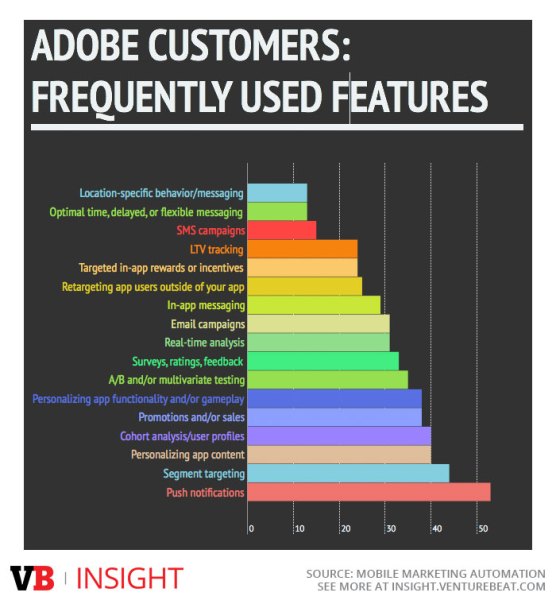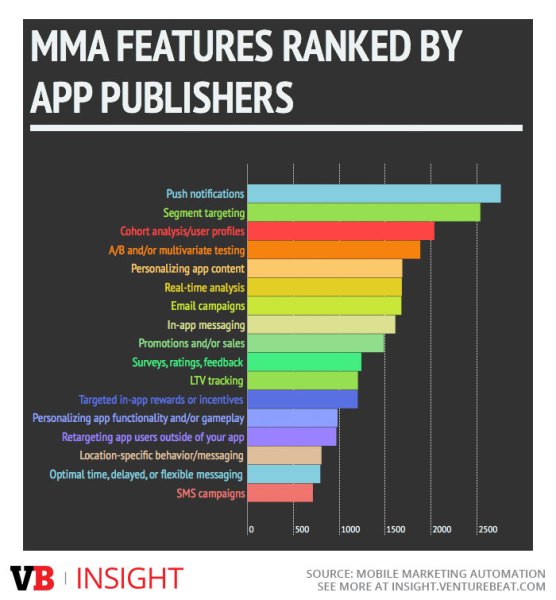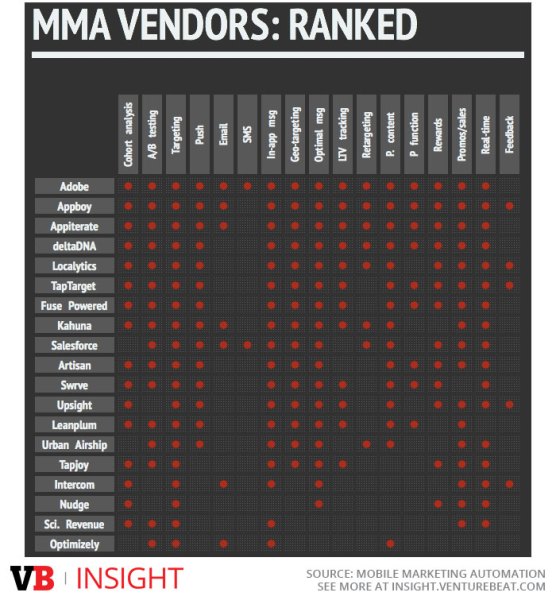Mobile marketing automation is the new new marketing tech that helps mobile publishers engage and monetize users in a very fine-grained manner, right down to the individual level. According to our recently released mobile marketing automation report, it’s currently poised to double or triple in market penetration in 2015.
How?
Young and nimble startups like Kahuna, Appboy, Leanplum, and Swrve helped to define and expand the market in 2014. Now, the big martech companies like Adobe and Salesforce, and the largest name in mobile notifications, Urban Airship, are popularizing it with their already large customer bases in 2015.

Above: The mobile marketing automation features that Adobe customers most frequently use, according to our VB Mobile Marketing Automation study.
I talked to Adobe about how the company is planning to bring all the components of its massive marketing cloud down to the very small, lightweight, and swift world of mobile. Turns out, it’s a team effort.
AI Weekly
The must-read newsletter for AI and Big Data industry written by Khari Johnson, Kyle Wiggers, and Seth Colaner.
Included with VentureBeat Insider and VentureBeat VIP memberships.
“Experience Manager helps you build apps and create experiences, Adobe Analytics helps marketers measure app usage, and Adobe Target and Campaign help with push messaging and optimizing messaging,” Suresh Vittal, VP of Adobe’s Marketing Cloud Strategy, told me.
 375 mobile developers with over 900 million MAU
375 mobile developers with over 900 million MAU
told us what’s working in mobile marketing automation
Adobe ties that all together under a “Mobile Services” tag, which integrates the components into its marketing cloud.
As far as that goes, it’s an interesting strategy that works well for large enterprises that already use Adobe Marketing Cloud — which are not typically the companies you look to for the next big mobile app hit. But it doesn’t really address emerging startup mobile companies.
So Adobe has a trojan horse to capture emerging mobile players as well, thanks to its 2011 purchase of PhoneGap.

Above: Mobile marketing automation features app publishers most care about, according to our study.
PhoneGap is probably the most popular cross-platform mobile development platform available. You write once, publish to iOS, Android, Windows, BlackBerry, and so on. For many kinds of apps, particularly those that are not processor-intensive, PhoneGap, used well, can deliver good user experience while also enabling a much more scalable development effort.
What Adobe has done is “tightly couple” its mobile SDKs with PhoneGap, meaning that it’s easy to integrate its cohort, campaign, targeting, and messaging components into your app. The result, Adobe said, is that you give developers and marketers “equal access” to apps. That means that without redoing the app or updating via Apple’s processes, marketers can update and modify their mobile customer experience. It also means that app publishers can set up diverging experiences for different users, needs, and times.
“For example, in a banking app, a young mom might be looking just at her checking balance,” Vittal said. “But a professional might be looking at her portfolio … their home pages are different, and they don’t have to follow the same click pattern.”
That’s powerful, and that’s cutting-edge for mobile marketers and customer experience managers.
Adobe has really done its homework on integration here, so that with one line of code, developers can add the SDK with all the components. The integration is on the backend management platform as well, so that after you’ve checked analytics in Target and created a segment based on a recent cohort of users, that segment is immediately available in Campaign to run promotions and messaging.

Above: How mobile marketing automation vendors stack up, according to our study.
The rub, of course, is that you’re going to have to be an Adobe Marketing Cloud client to get all that mobile goodness. And that’s going to cost significantly more than other mobile marketing automation solutions. For Adobe, that’s not really a problem — while it’s looking to be easy to start working with, its true focus is on businesses that will scale. And on businesses that have multiple units and multiple channels.
Which means that data you learn about a user on mobile comes into your customer profile, which incorporates all client data, including web, offline, and point-of-sale. And the converse is true: Things you know about your users offline, from the web, and at point-of-sale can be brought to bear in your mobile cohorts, targeting, and messaging.
Even cross device.
“Cross device and cross profile identity is extremely important. … It’s crucial to have a holistic customer view,” Vittal said. “We think mobile is dramatically important, but we believe mobile is even more transformational when it’s connected to all these channels.”
The big opportunity beside the PhoneGap integration?
Adobe is the seventh-largest provider of mobile app analytics on Android and the eighth-largest on iOS. Something like 10,000-15,000 apps use its analytics, between SDKs variously labeled as Omniture, Adobe Marketing Cloud, and Adobe Marketing Suite. As the company consolidates those and its features, and introduces mobile marketing automation to all its analytics clients, there’s significant room to grow.
That’s not unlike other major players in the space such as Salesforce and Urban Airship. But more on those in a future post.
VentureBeat's mission is to be a digital town square for technical decision-makers to gain knowledge about transformative enterprise technology and transact. Learn More
